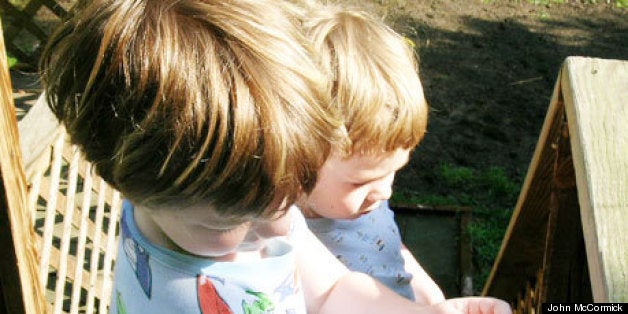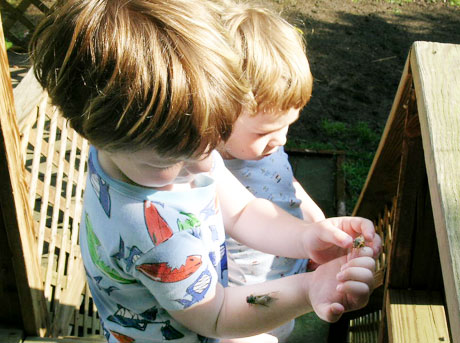
Cicadas. Who can think over the deafening roar of their buzzing? Who doesn't cringe when they molt and you walk across the driveway feeling the sickening crunch of their shells underfoot? And the thought of all those bugs bubbling from the ground is something straight out of a horror movie! It's enough to make your skin crawl.
I confess I used to think this way about these creepy crawlers. But then something happened nine years ago that changed forever the way I view these tiny creatures and how I teach my kids.
First, a little history.
In case you missed it, Craig Gibbs wrote a delightful op-ed in last Thursday's New York Times, celebrating -- of all things -- the wonder and mystery of the periodical cicada. According to Gibbs, an entomologist with the Wildlife Conservation Society, this spring many of us will witness a wildlife phenomenon occurring nowhere else in the world -- the emergence of the Brood II cicadas, seen only once every 17 years along the East Coast.
Unimpressed?
Gibbs argues you should be impressed. Cicadas are one of the longest living insects on earth. Of the approximately ten million insect species in the world, cicadas make up about 3,000. A mere seven species of those, called periodical cicadas and found only in eastern North America, spend either 13 or 17 years growing underground, until they emerge and transform into adults.
As soil temperatures rise over the next month, cicadas will leave their subterranean world for the first time since they tunneled underground as nymphs in 1996. The razor buzz of the males will be heard in a mating ritual that has existed since the ice age. Within a few weeks, they'll all be dead, millions if not billions of them, and their offspring won't reemerge until 2030.
The first time we took our boys to view the cicadas was 2004. My two sons, Connor and Will, had just turned 4 and 6-years-old. It was also the year that a different generation of cicadas, known as Brood X, emerged from the ground after 17 years in hibernation. My wife Danna and I found a spot in the neighborhood where the cicadas were particularly prolific, and set about teaching the boys the marvels of nature.
My sons were understandably cautious at first, but Danna was upbeat, describing the cicadas in a positive light, and taking photos of them as if they were movie stars. Danna said that the cicadas don't hurt the trees they lay their eggs on, and when they die, provide needed food for birds, reptiles and mammals. When the insects tunnel to the surface, they aerate the soil, and when they die, the cicadas return nutrients to the earth that once sustained them. All part of the cycle of life, she explained.
I watched my sons carefully to see if they were buying into mom's passionate ode to nature. The boys seemed to be warming up to the cicadas swarming around them when several flew up and landed on Connor.
"Dad!" he yelled. "Get them off me!"
I patiently removed the cicadas from his jacket, and tenderly placed them on the trunk of a nearby tree. "See how gentle they are," I told Connor. "They don't bite and only wanted to say hello."
Will called me over then, and I turned away to see what cicada mysteries he'd discovered.
In less than a minute, Connor yelled again. "Dad, they're back! Help!"
I whirled around. Connor was completely covered in cicadas now. I rushed over, expecting panic. Instead, a big grin stretched across Conner's face.
He'd picked up dozens of cicadas and adorned himself with their scaly bodies, hoping to get just this reaction from me.
I knew then that my kids were no longer afraid of the cicadas, or for that matter, of any quirky or bizarre creatures that nature might throw at them. My belief proved the test of time, as my boys have gone on to raise as pets two sets of dogs, a five-foot python, four crested geckos whose numbers multiply by the season, and a grumpy old lizard named Harry who, despite conventional wisdom, does on occasion bite the hand that feeds him.
For the next six weeks, we celebrated every stage of the cicadas' all too brief lives, and learned many lessons from them. We discovered that no matter how small, obscure, or weird one of nature's creatures is, it deserves respect and protection and has a story to tell. My wife and I also learned that fear of animals -- or of nature itself -- is taught and passed on from generation to generation. If we want our children to be true stewards and lovers of nature, we need to teach them to be so.
We were all sad when the cicadas passed away about a month later. But we were comforted knowing they had given our family a wonderful memory, and that when the next brood returned, my children would no longer be little boys, but teenagers.
A decade later, we're happy to see the next brood of cicadas returning once again, and that my boys, now towering teenagers, will be on hand to greet them. All part of the cycle of life.

John McCormick and his sons William and Connor are the authors of "Dad, Tell Me A Story," How to Revive the Tradition of Storytelling with Your Children (Nicasio Press 2010). For more information about family storytelling, visit the authors' website and blog at http://DadTellMeAStory.com.
You can also follow the authors on Twitter: https://twitter.com/DadTellMeAStory, or join them on Facebook: http://www.facebook.com/DadTellMeAStory.